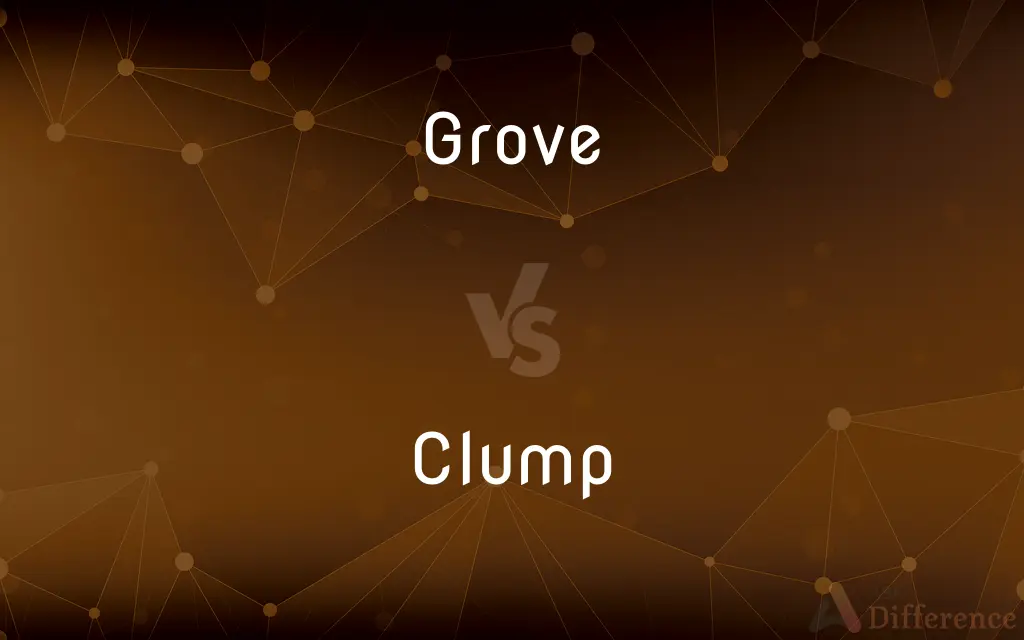Grove vs. Clump — What's the Difference?
Edited by Tayyaba Rehman — By Fiza Rafique — Updated on March 31, 2024
A grove is a group of trees growing close together without underbrush, often cultivated, while a clump refers to trees growing in a tight cluster, usually appearing more naturally and haphazardly.

Difference Between Grove and Clump
Table of Contents
ADVERTISEMENT
Key Differences
A grove typically consists of trees planted or growing in a deliberate pattern or spacing, emphasizing the absence of underbrush to maintain an open, accessible area. This setting is often found in parks, gardens, or agricultural landscapes, where the trees share species or aesthetic similarities. On the other hand, a clump of trees is characterized by its natural and somewhat random assembly of trees, which may include various species growing closely together. This formation is commonly seen in forests or natural landscapes, where trees have sprouted and expanded in clusters without human intervention.
Grove areas are frequently associated with human activities or designed landscapes, reflecting cultivation or maintenance efforts to create a pleasing environment. These spaces may serve recreational, aesthetic, or commercial purposes, such as orchards or memorial parks. Conversely, clumps are more indicative of nature's spontaneous grouping of trees, offering ecological benefits like habitat creation and contributing to the area's biodiversity through the random assortment of tree types.
In terms of appearance, groves are often orderly and open, allowing easy movement within and offering clear views of the sky, making them ideal for leisure activities and gatherings. Clumps, with their denser arrangement and variety of trees, can appear more rugged and provide a sense of seclusion and natural diversity, attracting wildlife and supporting complex ecosystems.
Management practices for groves include pruning, clearing underbrush, and sometimes planting specific tree types to achieve desired outcomes, such as fruit production or aesthetic appeal. Clumps, however, may require minimal human management, depending on the goal for the land; they might be left to grow wild or be lightly managed to encourage certain species or prevent overgrowth.
While both groves and clumps play significant roles in landscapes and ecosystems, their formation, appearance, and purpose offer contrasting experiences. Groves are curated spaces that reflect human aesthetic or functional intentions, whereas clumps represent the spontaneous and untamed aspects of nature.
ADVERTISEMENT
Comparison Chart
Definition
A group of trees without underbrush, often cultivated.
A naturally occurring tight cluster of trees.
Appearance
Orderly and open, with trees possibly of the same species.
Random and dense, with potentially mixed species.
Association
Cultivation and human maintenance.
Natural formation and ecological processes.
Purpose
Recreational, aesthetic, or commercial.
Habitat creation and biodiversity.
Management
Pruning, clearing underbrush, planting specific types.
Minimal or aimed at encouraging diversity.
Compare with Definitions
Grove
An intentionally planted cluster of similar trees.
The bamboo grove became a tranquil spot for visitors.
Clump
A natural cluster of trees growing closely together.
Deer were spotted in the dense clump of trees near the river.
Grove
Trees growing in open, accessible areas.
The oak grove was a popular spot for bird watching.
Clump
Trees spontaneously grouping in forests or wild areas.
The clump of ancient pines stood as a testament to the forest's age.
Grove
A cultivated group of trees without underbrush.
The apple grove provided a bountiful harvest this year.
Clump
A dense assembly of trees offering seclusion.
The clump of trees at the park's edge was a favorite hideaway for children.
Grove
A space in parks or gardens with trees spaced apart.
The grove offered shade and a perfect picnic location.
Clump
Minimal human interference in its formation.
The clump on the hillside flourished into a small woodland.
Grove
A managed collection of trees for specific purposes.
The cherry grove was in full bloom, attracting tourists.
Clump
Mixed species of trees forming a tight group.
The clump provided a varied habitat for birds and insects.
Grove
A small wood or stand of trees lacking dense undergrowth.
Clump
A clustered mass; a lump
Clumps of soil.
Grove
A group of trees planted and cultivated for the production of fruit or nuts
An orange grove.
Clump
A thick grouping, as of trees or bushes.
Grove
A small forest.
Clump
A heavy dull sound; a thud.
Grove
An orchard of fruit trees.
Clump
To form lumps or thick groupings.
Grove
A place of worship.
Clump
To walk or move so as to make a heavy dull sound.
Grove
A lodge of the Ancient Order of Druids.
Clump
To gather into or form lumps or thick groupings of.
Grove
To cultivate in groves; to grow naturally so as to form groves.
Clump
A cluster or lump; an unshaped piece or mass.
Grove
To cultivate with periodic harvesting that also serves to create order (gaps and lines of trees) to facilitate further harvesting.
Clump
A thick group or bunch, especially of bushes or hair.
Grove
To plough or gouge with lines.
Clump
A dull thud.
Grove
A smaller group of trees than a forest, and without underwood, planted, or growing naturally as if arranged by art; a wood of small extent.
Clump
The compressed clay of coal strata.
Grove
A small growth of trees without underbrush
Clump
A small group of trees or plants.
Grove
Garden consisting of a small cultivated wood without undergrowth
Clump
(historical) A thick addition to the sole of a shoe.
Clump
(ambitransitive) To form clusters or lumps.
Clump
(ambitransitive) To gather in dense groups.
Clump
(intransitive) To walk with heavy footfalls.
Clump
To strike; to beat.
Clump
An unshaped piece or mass of wood or other substance.
Clump
A cluster; a group; a thicket.
A clump of shrubby trees.
Clump
The compressed clay of coal strata.
Clump
To arrange in a clump or clumps; to cluster; to group.
Clump
To tread clumsily; to clamp.
Clump
A grouping of a number of similar things;
A bunch of trees
A cluster of admirers
Clump
A compact mass;
A ball of mud caught him on the shoulder
Clump
A heavy dull sound (as made by impact of heavy objects)
Clump
Make or move along with a sound as of a horse's hooves striking the ground
Clump
Come together as in a cluster or flock;
The poets constellate in this town every summer
Clump
Walk clumsily
Clump
Gather or cause to gather into a cluster;
She bunched her fingers into a fist
The students bunched up at the registration desk
Common Curiosities
What distinguishes a grove from a clump?
A grove is an intentionally maintained group of trees without underbrush, often for specific purposes, while a clump naturally forms with trees growing tightly together.
Are groves always man-made?
While groves often result from human planting and maintenance, they can also occur naturally but are usually maintained to some extent for recreational or commercial use.
Can a grove have only one type of tree?
Yes, groves often consist of a single species of tree, planted and maintained for uniformity or specific harvesting goals.
Why do clumps form in nature?
Clumps form due to natural seeding processes, environmental conditions, and ecological interactions, leading to spontaneous tree growth in close proximity.
How does biodiversity differ between groves and clumps?
Clumps, with their natural and mixed-species composition, typically support higher biodiversity compared to the more uniform and often single-species groves.
Can clumps be found in urban areas?
Yes, clumps can be found in urban areas, especially in parks, natural reserves, or undeveloped lands where trees have been allowed to grow spontaneously.
Do clumps contribute to the ecosystem?
Yes, clumps contribute significantly to ecosystems by providing habitat, promoting biodiversity, and supporting various wildlife species.
How are groves and clumps managed differently?
Groves require regular maintenance such as pruning and underbrush clearing, while clumps may only need minimal intervention to maintain natural growth patterns.
What aesthetic values do groves and clumps offer?
Groves offer a manicured, orderly aesthetic ideal for parks and gardens, whereas clumps provide a natural, wild appearance that can enhance the beauty of natural landscapes.
Is water conservation different between groves and clumps?
Yes, groves, especially in agricultural settings, might require irrigation, while clumps rely on natural rainfall, potentially contributing to water conservation.
What role do groves play in agriculture?
In agriculture, groves are used for cultivating fruit trees or nuts, providing an organized approach to farming and harvesting.
How do groves and clumps affect local wildlife?
Groves can provide food and shelter for wildlife, especially if they include fruit trees, while clumps offer diverse habitats due to their variety of tree species.
Can a grove become a clump over time?
A grove can appear clump-like if left untended and allowed to grow naturally, but it usually retains some characteristics of its original planting.
Can the creation of a grove impact the local ecosystem?
Creating a grove can impact the local ecosystem by introducing new species or altering the landscape, which can affect native species and habitats.
Why might someone prefer to create a grove over leaving a clump?
Someone might prefer creating a grove for specific purposes like agriculture, aesthetics, or recreational use, seeking control over the landscape’s appearance and utility.
Share Your Discovery

Previous Comparison
Salutation vs. Salute
Next Comparison
Paganism vs. ShamanismAuthor Spotlight
Written by
Fiza RafiqueFiza Rafique is a skilled content writer at AskDifference.com, where she meticulously refines and enhances written pieces. Drawing from her vast editorial expertise, Fiza ensures clarity, accuracy, and precision in every article. Passionate about language, she continually seeks to elevate the quality of content for readers worldwide.
Edited by
Tayyaba RehmanTayyaba Rehman is a distinguished writer, currently serving as a primary contributor to askdifference.com. As a researcher in semantics and etymology, Tayyaba's passion for the complexity of languages and their distinctions has found a perfect home on the platform. Tayyaba delves into the intricacies of language, distinguishing between commonly confused words and phrases, thereby providing clarity for readers worldwide.
















































